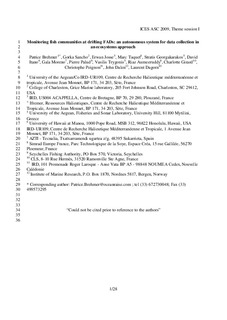| dc.contributor.author | Brehmer, Patrice | |
| dc.contributor.author | Sancho, Gorka | |
| dc.contributor.author | Josse, Erwan | |
| dc.contributor.author | Taquet, Marc | |
| dc.contributor.author | Georgakarakos, Stratis | |
| dc.contributor.author | Itano, David | |
| dc.contributor.author | Moreno, Gala | |
| dc.contributor.author | Palud, Pierre | |
| dc.contributor.author | Trygonis, Vasilis | |
| dc.contributor.author | Aumeeruddy, Riaz | |
| dc.contributor.author | Girard, Charlotte | |
| dc.contributor.author | Peignon, Christophe | |
| dc.contributor.author | Dalen, John | |
| dc.contributor.author | Dagorn, Laurent | |
| dc.date.accessioned | 2012-02-07T08:12:39Z | |
| dc.date.available | 2012-02-07T08:12:39Z | |
| dc.date.issued | 2009 | |
| dc.identifier.citation | This report is not to be quoted without prior consultation with the General Secretary. | no_NO |
| dc.identifier.uri | http://hdl.handle.net/11250/102950 | |
| dc.description.abstract | An increasing proportion of landings by tuna purse seine fishing vessels are taken around drifting
Fish Aggregating Devices (FADs). Although these FADs and their use by the fishing industry to
capture tropical tuna have been well documented, operative tools to collect data around them are
now required. Acoustic, video, photographic and visual data were collected on fish aggregations
around drifting FADs in offshore waters of the western Indian Ocean. Multibeam sonars,
multifrequency echosounders, pole-mounted digital video camera and an automated 360° rotating
digital photographic camera were deployed from a vessel in the vicinity of FADs, and their
observation capability evaluated with underwater visual census made by divers. Two prototypes
of instrumented buoys equipped with scanning sonar were tested providing positive results on
their feasibility and operability as pelagic observatory. Acoustics methods combined with digital
underwater video represent interesting possibilities to remotely study the composition and
behaviour of these fish aggregations. The acoustic methods allowed the accurate description of
the spatial organisation and dynamics of individual fishes, schools and biotic scattering layers
around the FAD, but species identification was difficult. In situ visual, photographic and video
observations systems permitted species identification within a range of 0 to ~ 25 m. However,
scuba divers observations were more efficient compared to the photographic and video cameras
at detecting the presence of certain fish species around FADs. Obviously both methods are
complementary, since the acoustic methods could not identify most fish species and could not detect the presence of small fishes found less than 5 meters under the FAD. These fishes
represent a small part of the overall biomass of fish aggregations but they are part of the
biodiversity of pelagic ecosystems and may play a major role in ecological processes associated
with FADs. The opportunity to incorporate observation tools into the development of future
autonomous instrumented drifting buoys for remotely monitoring fish diversity and abundance in
the pelagic ecosystems is presented. The perspective of autonomously collecting large amounts of
basic information useful for ecological and fisheries studies in an ecosystemic approach for open
sea or coastal pelagic environment is emphasized.
Keywords: Visual and video Fish census / Acoustics / Buoy system / Pelagic species /
Monitoring / Observatory. | no_NO |
| dc.language.iso | eng | no_NO |
| dc.publisher | ICES | no_NO |
| dc.relation.ispartofseries | ICES CM documents;2009, Theme session I | |
| dc.subject | acoustics | no_NO |
| dc.subject | akustikk | no_NO |
| dc.subject | pelagic fish | no_NO |
| dc.subject | pelagisk fisk | no_NO |
| dc.subject | tuna | no_NO |
| dc.subject | tunfisk | no_NO |
| dc.title | Monitoring fish communities at drifting FADs: an autonomous system for data collection in an ecosystems approach | no_NO |
| dc.type | Working paper | no_NO |
| dc.subject.nsi | VDP::Agriculture and fishery disciplines: 900::Fisheries science: 920::Resource biology: 921 | no_NO |
| dc.source.pagenumber | 28 s. | no_NO |
